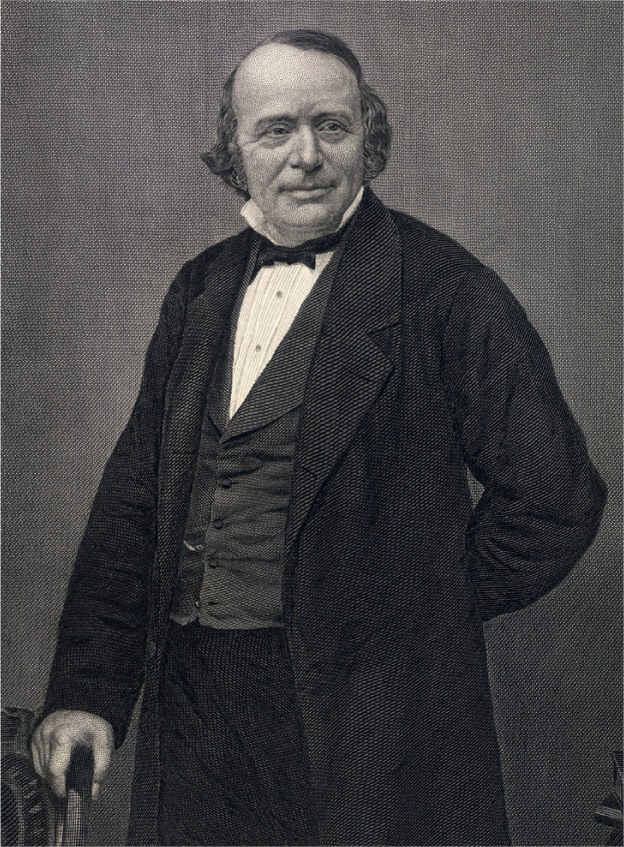
Louis Agassiz (1807–1873).
Some experiments, like Faraday’s attempt to make induced electric current with his iron ring, produce results you do not expect, but provide powerful new insights. Others produce exactly the results the experimenter expected, providing powerful evidence to persuade doubters that a new theory is correct. Just such an experiment was carried out in the 1830s by the Swiss geologist Louis Agassiz, to support his contention that the Earth had once been covered by ice.
At that time, there was a debate about the origin of boulders found at various locations across Europe far away from the rock strata to which they belonged. The traditional explanation was that these rocks, known as erratics, had been carried there by the Biblical Flood. But a minority view was that they had been carried to their present locations by ice sheets spreading out from the north and down from the mountains during a great glaciation. Agassiz started out firmly convinced that the Flood story was right, and in 1836 made a field trip to the mountains with the intention of finding evidence to prove the glaciation idea was false. Instead, he soon convinced himself that the distribution of these erratics, the smoothness of rock surfaces polished by the action of glaciers, scratches in the rock scoured by stones dragged along by glaciers, and other evidence supported the idea. He started promoting it, and in 1837 coined the term Ice Age (in German, Eizeit). That year, in his capacity as President of the Swiss Society of Natural Sciences, he introduced the term in his Presidential Address, which he used to present the evidence and tell his colleagues that: ‘In considering the intimate connection between the different facts which we have just been describing, it is manifest that every explication which does not account at the same time for the polish of the surface of the soil, for the superposition and the rounded form of the pebbles, for the sand reposing immediately upon the polished surfaces, and also for the angular form of the great superficial blocks, is an explication which is quite inadmissible as accounting for the erratic blocks of the Jura; and these objections forcibly apply to all the [other] hypotheses respecting the transport of blocks with which I am acquainted.’16

But his colleagues in the Swiss Society of Natural Sciences ridiculed the idea. So he devised an experiment to test the power of ice in moving boulders.
The experiment was disarmingly simple. Agassiz set up a shelter grandly referred to as an observing station (actually a little hut) on a rocky outcrop in the Aar glacier in the Swiss mountains. He hammered stakes into the ice nearby, and returned each summer to measure how far the stakes had been carried by the glacier, flowing downhill like a river of ice, and to add more stakes. Over the next three years, he found that the ice moved even faster than he had anticipated, and he observed large boulders being carried along with the ice. He inferred that in the relatively recent past Switzerland had been covered not by a few glaciers on the high Alps, but by a single great sheet of ice, spreading out from the higher Alps and covering the whole valley of northwestern Switzerland. The ice sheet would have been blocked by the Jura mountains, piling up behind them to reach the height of the peaks of the range. And the same sort of thing would be happening across Europe, and beyond – a Great Ice Age.

In 1840 Agassiz published a book spelling out the evidence for an Ice Age and elaborating on the theme. The book, Étude sur les Glaciers (Studies on Glaciers), was something of a sensation, not least because of Agassiz’s dramatic prose: ‘The earth was covered by a huge ice sheet which buried the Siberian mammoths, and reached just as far south as did the phenomenon of erratic boulders. This ice sheet filled all the irregularities of the surface of Europe before the uplift of the Alps, the Baltic Sea, all the lakes of Northern Germany and Switzerland. It extended beyond the shorelines of the Mediterranean and of the Atlantic Ocean, and even covered completely North America and Asiatic Russia. When the Alps were uplifted, the ice sheet was pushed upwards like the other rocks, and the debris, broken loose from all the cracks generated by the uplift, fell over its surface and, without becoming rounded (since they underwent no friction), moved down the slope of the ice sheet.’17
Also in 1840, Agassiz visited Britain, where he met some of the leading geologists of the day and went on a field trip around Scotland to show them first hand the evidence in support of the Ice Age theory. The two most senior geologists, William Buckland and Charles Lyell, were convinced, and it was arranged that the two of them, plus Agassiz, would present papers on the Ice Age theory at two meetings of the Geological Society of London later that year. These presentations, on 18 November and 2 December 1840, mark the time when the Ice Age theory came in from the cold, although there was at that time no explanation for why the Earth had been so much colder in the past (see here).